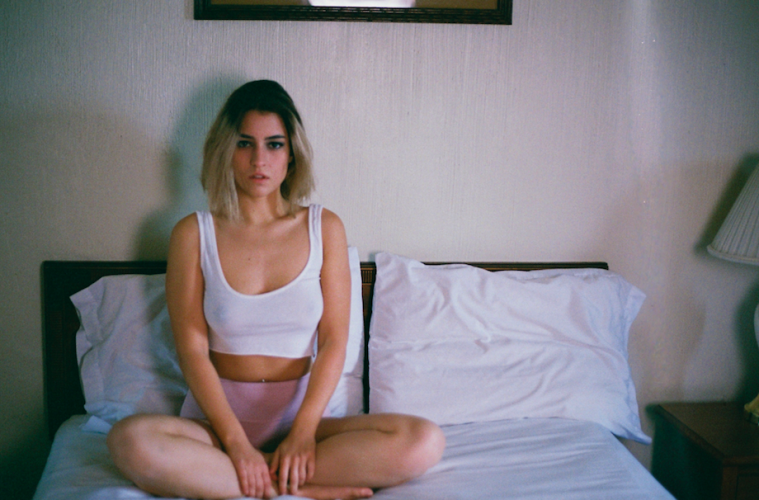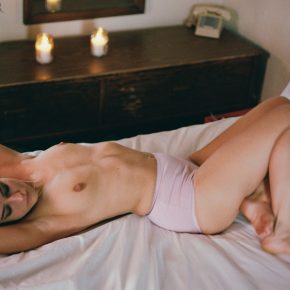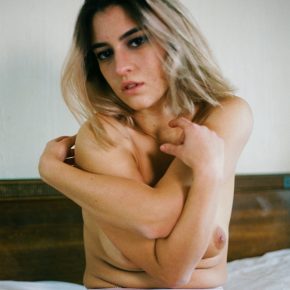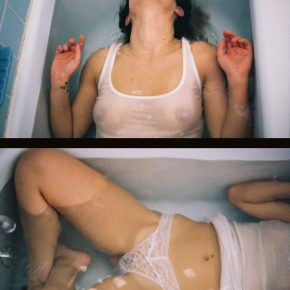Words Shelby Shoup | Images Alexander Castaneda
Independent creative, Claire Voyant, is not only a high fashion and editorial model; she is a crusader for women’s rights. Her modeling career began shortly after she experienced a sexual assault in 2014 and continues to be a motivating factor in her work today.
Claire experiments with nude modeling as a way to express her healing process through art and finds it to be a therapeutic way to work through her suffering. Not only does Claire work in front of the camera, but also is an active collaborator and performance artist, each medium allowing her to express different parts of herself.
She has been using her voice and her work as a platform to discuss women’s issues, especially women’s sexuality and violence against them. Her latest work with Detroit photographer, Alexander Castaneda, at the Palms Motel is no exception.
I was able to discuss with Claire this photo series, her move from Detroit to Philly, as well as her plans for the future.
(Claire at Palms Motel | Alexander Castaneda)
Talk a little bit about this project at Palms Motel. What was the inspiration? How was the collaboration? And what do you think this location and set have to say about your work and passions?
“When Alex and I were planning our collaboration last fall, I had been traveling a lot. Being a traveling model, I’ve had to spend a good amount of time shooting paid work in hotels and staying in them on the road alone. This was a really difficult reality for me to accept, first, because I was assaulted in a hotel in 2014. The Palms is exactly what you imagine when you think of an old, skeezy motel in a blue-collar area. Actually, it’s only a few miles from where I grew up so I guess you could say it was “close to home”. I was interested in exploring feelings of risk, loneliness and being unsafe that often accompany me in my travels and in my shoots.”
You say you’re interested in exploring feelings of risk etc.; how would you explain why you physically seek out these uncomfortable situations to someone who may not understand wanting to put themselves in a place where they may be easily triggered?
“After experiencing an assault, both body and mind are changed to protect the victim. Small actions of people around send me into what I call, ‘survivor mode’ each and every day. Men looking at me in a certain way on the bus, someone who seems to stand purposefully in front of an exit, a person who appears to be following me for too many grocery store aisles or subway stops. A victim’s brain becomes required to protect itself and it becomes a new experience to exist in public spaces. These are sensations that are present daily, with little opportunity to delve in and explore them the way creating a space with a male photographer and nudity does. The dynamic of power and control between myself and collaborator that is created is a microcosm of the feelings of uncertainty and risk that I confront in public spaces every day. It’s also forced me to practice confronting these. It’s given me a space to say, no, these are not ‘perceived risks’ – these are true, actual, real threats of being a single woman who lives boldly in America today.”
Nudity has undoubtedly been a controversial topic recently, especially with campaigns such as #freethenip holding protests throughout the country. How do you see nudity as a positive expression for women and girls?
“Aha, yes, nudity definitely is a controversial topic. I see it on a daily basis trying to determine how and what to put out on social media. When I think about nude modeling, I basically break it into two parts. Yes, nudity is an important facet of self-expression for women at this time because of our political and social climate, because of body shaming, assault rates, rape culture and all of these topics. But beyond that, I also think that nudity is a vital facet of self-expression for people in general, regardless of gender. We live in our bodies, and our bodies are: naked. Once you can strip the objectification or sexualization from an image of a nude body, you’ll find a lot of emotion there. This isn’t all about me being a naked woman. A lot of my work is just about living in a body that is imperfect.”
Do you think every shoot you participate in helps you tackle a new issue in regards to your assault? If so, what do you think this shoot at the Palms Motel helped you work through?
“Every shoot is not a masterpiece, but I like to think that each shoot is productive in some way. I’m glad I have gotten to the point where I can say that. Some shoots are collaborations where I can crack open something raw and try to spill it out on film, but then again many are not. Each time I agree to work with a photographer, I am putting myself into a place of vulnerability. To try to create while being naked is hard enough for anyone. As a person who has experienced assault, many days feeling safe in a room with a man I’ve never met – that is the accomplishment itself. If all of the film from this set at The Palms Motel had expired, if no images came out of it, I still had that experience of pushing myself to be vulnerable.”
“Victoria was one of my very favorite projects to date. It was a concept I had been toying with for over a year. Between a gender studies class, I was taking at Wayne State and a painting studio I was figure modeling for I felt like I was really immersed into both of those archetypes of women. That was my first venture into performance art and I haven’t done anything similar since. I’m sure that I will, I find performing to be such a rush, but that’s just not the environment I’m in now. I don’t box myself into this medium or that medium; if I did I would have never created Victoria. The only theme of my work is that I create from the human form because those have always been the topics I wanted to explore. My most significant project now is a self-portrait series about the way women engage in self-harm through beauty practices. I like switching it up and making it clear that although I am the model, and although many people credit the photographer with the creation of the images, I have a message that I am pushing out there.”
Do you think that if you were using a different art medium, your growth, both artistically and mentally, would have progressed more slowly?
“Yes, my medium as of late has been intentionally collaborative and purposefully centered on my body, nudity and sexuality. It’s the logical form to explore safety and expression with another person. I think you’ll see me move more into self portraits in the next year or so, definitely a mark of my healing and change of focus.”
You recently moved from Detroit to Philadelphia, in which ways are the modeling/art scenes different? Has Philadelphia presented any new opportunities that you may be working on soon?
“Philadelphia is so different from Detroit. There is a much wider and more complicated network here. Detroit has very few fine art photographers, which meant I had to travel a lot previously. On the east coast are many of my wish list photographers. I used to spend hours on Tumblr looking at Scott Worldwide and Mikey McMichaels work before I was a model, and to call them collaborators and friends now is a “pinch me” kind of feeling. I also am really excited to be working with artists like John Narvon, who is a shibari rigger and photographer, and I definitely see myself leaning more into suspension in the future. It’s all about pushing myself to make the next step. It’s fucking hard to live with momentum, that’s what this big move was all about.”
Claire’s work, and what she has to say about it, brings up a systematic issue that has been lurking in American culture for a long time; the objectification and over-sexualization of women.
To some, it may be counterintuitive for a woman who has been a victim of sexual assault to explore these issues while still modeling and posing nude. However, as Claire brings up, often times these photographer/model situations are much more controlled and safe than situations women are put in everyday. It is hard to explore a feeling out in a public space while still being vigilant about your safety.
I believe Claire’s work exemplifies social and cultural change, where women are in charge of the images and stories their bodies create. I hope this type of work influences others to support women’s voices when they speak out against the injustices they suffer everyday.
Domestic Violence Help in Michigan
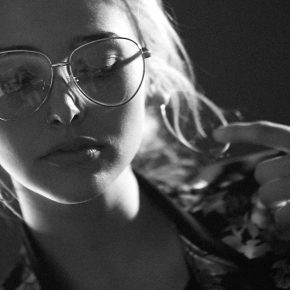 Hi, I’m Shelby Shoup and I’m a journalist, activist and creative. I have many interests but the passion that connects them all is story telling. I hope my ability to share and create stories will inspire you. Learn more at
Hi, I’m Shelby Shoup and I’m a journalist, activist and creative. I have many interests but the passion that connects them all is story telling. I hope my ability to share and create stories will inspire you. Learn more at
